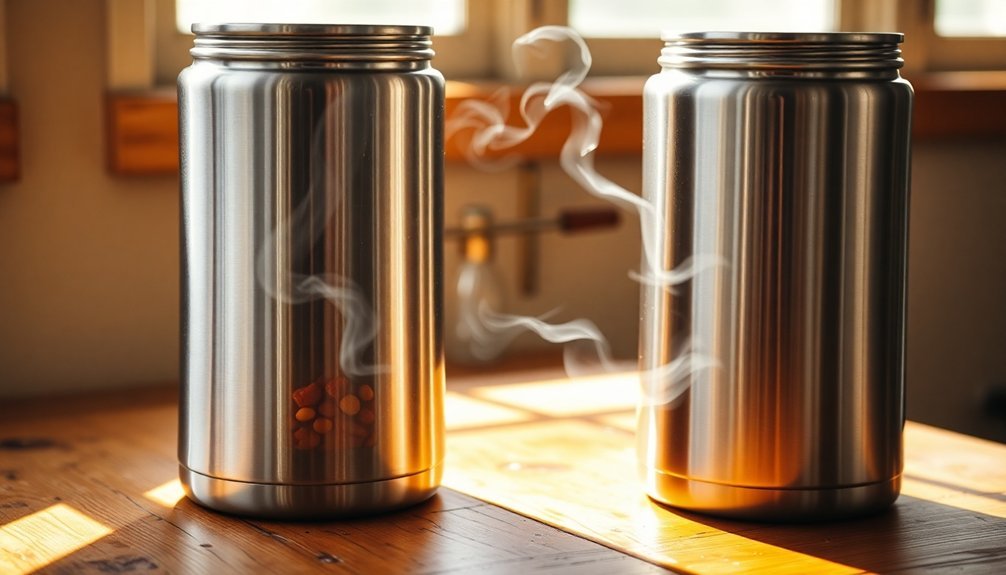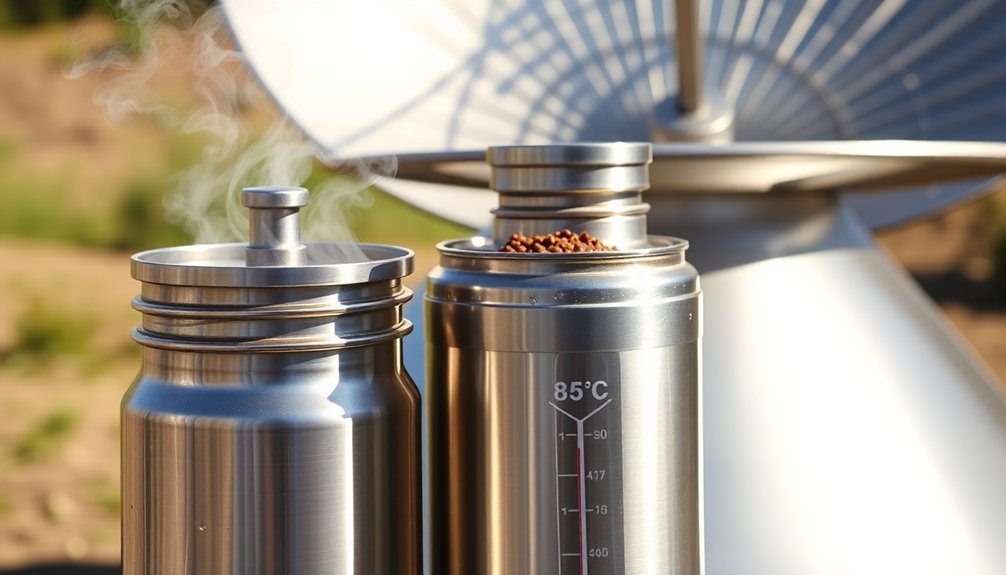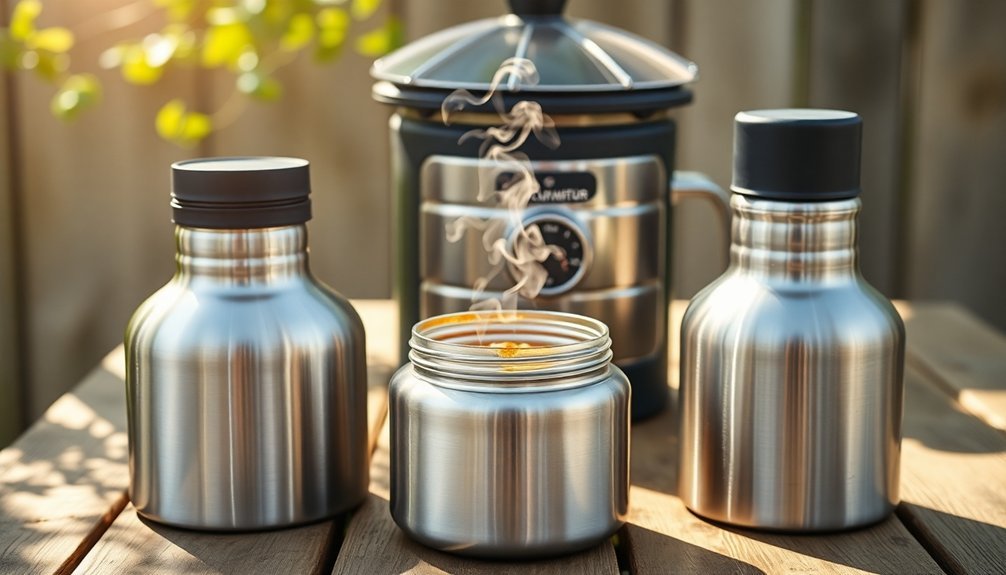You'll keep your sun-cooked meals piping hot for up to 12 hours with the right vacuum-insulated flask. Double-wall construction with a near-vacuum space prevents heat transfer, while reflective interior coatings maximize temperature retention. For best results, position your solar cooker in direct sunlight between 11 am and 3 pm, then transfer your hot meal to a tall, narrow flask filled to capacity. Choose a flask with quality seals and proper neck design, as heat typically escapes from this area. The combination of smart solar cooking and proper storage techniques opens up a world of sustainable meal possibilities.
Understanding Vacuum Flask Technology

While many people use vacuum flasks daily, few understand the ingenious technology that keeps their beverages at the desired temperature. Your vacuum flask works through a clever double-wall design with a near-vacuum space between the walls. This vacuum prevents heat transfer through convection and conduction, while reflective coatings minimize heat loss through radiation.
You'll find the inner vessel is typically made of glass or stainless steel, materials that won't affect your drink's taste. The outer layer, usually metal, adds protection and insulation. A tight-fitting stopper completes the system by preventing air movement.
The only significant heat transfer occurs at the neck where the two walls connect. The flask's efficiency depends on the quality of its vacuum seal and the materials used in construction. These vessels were first developed by James Dewar in 1892 during his groundbreaking cryogenic research.
Choosing Your Heat Retention System
Selecting the right heat retention system starts with understanding your specific needs. If you're mainly storing hot beverages, look for flasks with double-wall construction and vacuum insulation, as these features effectively minimize heat loss through conduction and convection.
For maximum temperature retention, choose flasks with reflective interior coatings that bounce heat radiation back inside. The thermal mirror coating helps prevent radiation heat loss by reflecting energy back to the contents.
You'll want to pay attention to the neck design since that's where most heat escapes. If you're planning to store cold drinks, you'll find they stay cool longer than hot drinks due to smaller temperature differences with the surrounding air.
Consider the manufacturer's temperature retention specifications and match them to how long you'll need your drinks to maintain their temperature.
For extreme conditions, specialized designs with additional features like foam insulation offer enhanced performance.
Cooking With Solar Power

As sunlight streams freely onto Earth's surface, you can harness this abundant energy source to cook meals using specially designed solar ovens. You'll need to position your cooker in direct sunlight between 11:00 am and 3:00 pm, adjusting it regularly to follow the sun's path. These ovens use reflective surfaces to concentrate sunlight effectively.
| Cooker Type | Best Uses | Key Features |
|---|---|---|
| Box Cooker | Stews & Casseroles | Insulated box, glass window |
| Panel Cooker | Soups & Warming | Lightweight, portable |
| Parabolic | Grilling & Frying | High temperatures, curved design |
For ideal results, cut ingredients into small pieces and use dark-colored pots with tight-fitting lids to maximize heat absorption. While cooking times are longer than conventional methods, you'll find solar cooking particularly effective for warming soups, melting cheese, and preparing one-pot meals. Remember to monitor food temperatures with a thermometer for safety.
Meal Planning and Storage Tips
Smart meal planning with insulated flasks opens up endless possibilities for enjoying hot or cold food on the go.
You'll get the best results by using dehydrated ingredients for hot meals like soups and chili, or preparing cold-soak salads with pre-cooked items that rehydrate in 1.5 to 3 hours.
To maximize your thermos's efficiency, fill it to capacity and choose recipes that don't need frequent stirring.
If you're sharing meals, a 24-ounce thermos works well for two people.
You'll want to opt for tall, narrow designs over wide ones, as they retain heat better due to less surface area.
Don't forget to maintain your flask's performance by checking the silicone sealing ring regularly and cleaning thoroughly to prevent odor transfer and flavor contamination.
Smart Energy Conservation Methods

Modern energy conservation methods have revolutionized how we manage household power consumption through integrated smart technologies.
You'll find significant savings with ENERGY STAR certified smart thermostats, which cut heating costs by 10-12% and cooling costs by 15%. These devices learn your schedule and adjust temperatures automatically when you're away or sleeping.
Smart lighting offers another powerful way to reduce energy use, with ENERGY STAR certified bulbs using 90% less power than incandescent ones while lasting 15 times longer.
You can integrate these with Smart Home Energy Management Systems (SHEMS) to maximize efficiency. Add smart plugs to control idle power consumption and automatically shut off unused devices.
Together, these technologies create a thorough approach to energy conservation, allowing you to monitor and optimize your home's power usage effortlessly.
Frequently Asked Questions
Can Insulated Flasks Be Used to Keep Cold Beverages Chilled?
Yes, you'll find insulated flasks excellent for keeping beverages cold! Their double-walled vacuum design and airtight seals prevent heat transfer, allowing your drinks to stay chilled for up to 24 hours.
How Often Should Vacuum Seals in Thermos Flasks Be Replaced?
You'll need to replace your thermos vacuum seals every 12-18 months, or sooner if you notice signs of wear, leaks, or reduced insulation. Regular inspections can help you identify when it's time for replacement.
What Safety Precautions Should Be Taken When Cleaning Insulated Flask Interiors?
You should avoid harsh chemicals like bleach and scouring powders. Don't submerge the flask in water. Use mild soap, a bottle brush for scrubbing, and make certain it's completely dry before storing.
Are There Specific Foods That Should Never Be Stored in Thermos Flasks?
You shouldn't store acidic drinks, dairy products, carbonated beverages, or traditional Chinese medicines in your thermos. These items can corrode the interior, promote bacterial growth, and potentially release harmful substances into your drink.
Do Different Colored Thermos Flasks Affect Heat Retention Performance?
No, your thermos flask's color doesn't affect its heat retention. The material, vacuum insulation, and seal quality are what matter. You'll get the same performance whether you choose black, silver, or any other color.
In Summary
You've got all the tools needed to maximize your solar cooking and heat retention efforts. By combining an efficient vacuum flask with smart meal planning and proper storage techniques, you'll keep those sun-cooked meals piping hot for hours. Don't forget to monitor your flask's performance and maintain it well. Making the most of solar energy isn't just eco-friendly – it's a practical way to enjoy hot meals anywhere.





Leave a Reply